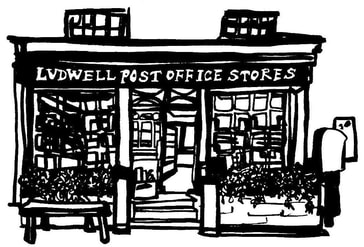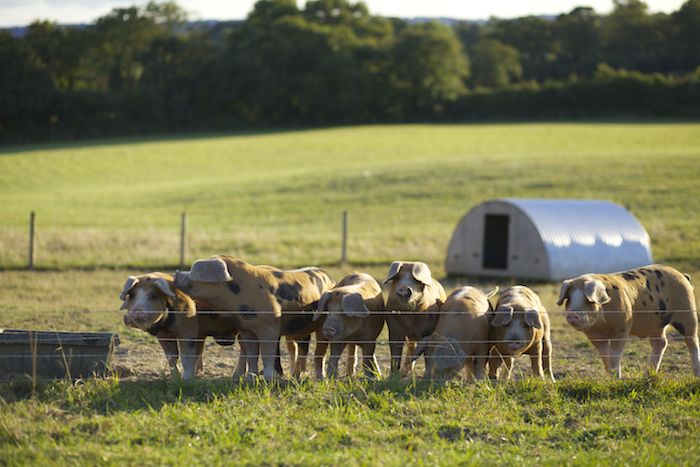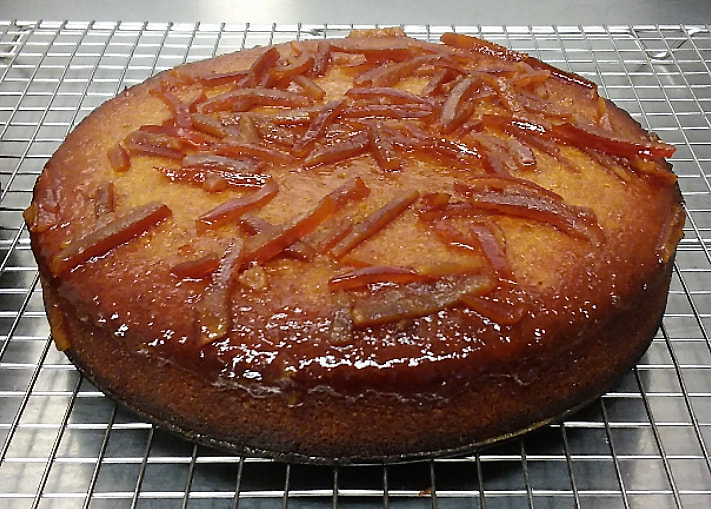|
In September 2007 when we completed the purchase of Ludwell Stores we were under the mistaken impression that we were buying a shop. It soon became obvious that we were buying something far more complicated and that it would not be ours until we had proven ourselves worthy. A village shop is a curious entity very much greater than the sum of its parts. It is a village green, a lost and found, a place for meeting and greeting, for organising events, for finding help, for swapping recipes, for passing news; and you can buy groceries. As the proprietors you are nothing without the goodwill and support of the community and if you get it wrong you own nothing. I lost my lovely Mum to aggressive cancer this year. She was a gentle person with a generous heart but she was very anxious when Phil and I first announced that we were off to buy a village shop. We had previous success at throwing our life in the air and seeing where it landed, but for her this was a toss too far. Nevertheless, she magnanimously trekked cross-country from Essex to provide practical assistance whenever we were desperate. One particularly busy Monday morning we put her on phone duty, and she accepted a call from a local gentlemen asking if we sold “patty”. “Paté?”, said my mother, all pure vowels and telephone voice. “Yes, of course!”. “No putty!” answered the gentleman. My mother looked bewildered as I nodded encouragingly at her. “Yes, apparently that too!”, she replied. She was in her very own “Two Ronnies” sketch and dined out on this story for years. She could never quite believe the diversity of the range and services crammed into the tiny space. When our predecessor, the lovely Cherry Renshaw, finally handed over the keys she also gifted us a scruffy green rope dog lead. “You’ll need this,” was her passing shot. Phil and I rolled our eyes and hung it on a peg. It was not the only thing that Cherry left and we assumed that it was just another piece of Ludwell flotsam. How wrong we were. In those early years we were the repository for every lost and wandering dog in the parish. We have also herded swans, hares, chickens, sheep and cows off the A30 and have provided advertising space for all manner of missing pets from ferrets to peacocks. It has always been a community service and has also provided plenty of amusing chatter. Some years ago when Mel Blanc, the voice of Warner Brothers died, a poster was published of Bugs Bunny and the other WB Greats standing silently around an unattended microphone. The caption read “Speechless”. I was reminded of this poster during the first week of the 2020 Spring lockdown. Suddenly without the ebb and flow of babbling customers Ludwell Stores was rendered speechless. We allowed one customer to shop at a time, which was fraught with pressure on both sides of the counter. It was military and miserable. However, we were saved by a wonderful band of local volunteers who stepped up like a flotilla of tiny boats to marshal and deliver and assist. It soon became obvious that the shop had not lost its voice but that the chatter had just moved outside. There was conversation and laughter, new friends were made and new contacts established by the side of the A30. The volunteers kept the soul of the shop alive when we were just too frantic to do it ourselves. We are hugely thankful to all those who lent a hand. We have always been blessed with extraordinary support from our team, from our customers, from our suppliers and from our long-suffering family. It may take a village to raise a child, but it takes many villages to sustain a village shop. Every success that the Stores has achieved, from winning Village Shop of the Year to simply being a healthy small business bobbing about in the local economy, is the result of collaboration. We are very fortunate to be a part of something so much larger than ourselves. Orignially published in The Donhead Digest Winter 2021/2022.
0 Comments
We have decided to draw a line in the sand.
We have for too long sold products that don't live up to our own ethical stand on food and its provenance. At home, we eat only organic and free-range animal produce; meat, eggs, milk etc. (see Angel Cottage and Ivy House). We are therefore withdrawing products which show no inclination to profess any good husbandry and replacing them, where possible, with local and humane alternatives (e.g. see Capreolus). There are arguments that organic and free-range offer no better quality or health benefits than high intensity farmed products. We disagree, but nevertheless, the higher ground must belong to those with the best animal husbandry. Realising that our New Season Seville orange marmalade stocks were running low, Phil decided to make some Blood Orange marmalade as they had just come into season.
"I thought it would be a lovely marmalade; with lemon juice added to the Blood Oranges it couldn't fail!....But it did. I thought it had set and jarred it all up. The next day it was still gloopy, so I emptied all the jars (28!) back into the pans and tried again. Even with the addition of more lemon juice and some pectin and definite wrinkles when set-tested, the next day it had still not set - but now it was as dark as treacle (tasted gorgeous mind you)." So, what to do? Phil decided to substitute the marmalade for the sugar and lemon in his usual Lemon Polenta Cake and use some of the marmalade as a glaze/drizzle and hey presto a new star was born. With my nose deep in textbooks at the moment I sometimes miss the latest food trend or tag. However having recently watched the BBC's Horizon: Clean Eating - The Dirty Truth programme with the shrewd and delightful Dr Giles Yeo, I was reminded of this trend in January's delicious magazine. In their "a good rant" at the back, Anthony Warner (The Angry Chef; see details at end), whose blog is not for the faint-hearted (or clean-eating), argues against the "increasingly crowded wellness market...as more new bloggers, Instagram stars and bandwagon-jumping celebrities appear." The meat of his delightful diatribe against "clean-eating" is a meat we should all be chewing on more enthusiastically.
"The key to a healthy relationship with food is to embrace as much variety as possible and try to keep some balance. To arbitrarily exclude anything is quite the opposite of what we should be doing. Eating is one of life's great joys. "There is no such thing as a healthy food, or an unhealthy one. Healthy eating is about balance. Despite what the media would have you believe, the advice from scientists has remained fairly consistent over the years. Eat a balanced diet, lots of fruit and vegetables, not too many calories, not too much salt. Try not to become overweight; it’s bad for you. If you do, you are eating too many calories so cut down a bit. "Sugar is not bad for you. Too much sugar is bad for you. Too much sugar and too much fat is even worse for you. Too much water is bad for you. Too much kale is bad for you... It is all a question of balance". Have we simply become desensitised to the phrase "a balanced diet"? Anthony Warner is a development chef by day and blogs as The Angry Chef by night (angry-chef.com). Twitter handle is @One_Angry_Chef Jo and I give chocolate advent calendars to the kids every December from the shop, usually Lindt. But this year we decided to get them something that they would realise wasn't a leftover/overstock from the shop, but a thoughtful gift. So we ordered them from Hotel Chocolat. Anyway there was one Montezuma Organic Chocolate Advent Calendar left over in the shop which Jo and I reluctantly (!) agreed to share. Now Sunday breakfast is a big meal for us and we never read at table anyway. It was my turn for an Advent Chocolate! A perfect start to a fine, sunny, crunchy, cold December Sunday. No spectacles at table which means I can't see what the day is on the calendar! "Is that today's?" "No Daddy...give it here". They both disappear: - my chocolate-loving daughter and my Organic Chocolate Advent Calendar! Fortunately, she returns with a similar number of windows open as when they left. But now, there are big numbers on the calendar! Thank you!
Chocolate Advent Calendar producers please note. I started studying for a Higher Diploma in Food and Nutrition Science in January 2016. It is comprised of 8 modules including Biochemistry, Cell Biology, Physiology as well as a Research Project. It should take about 2 years - 4 modules per year.
After 3 modules and with Christmas on the horizon, I decided a break was in order, so decided to start the next module (Nutrition II) in January. However, still waking at 04:30, it was obvious another project was required. Having had a look at our old website I realised not only how out-of-date it had become but also how clunky it looked (which had been a design feature to begin with, yes believe it, that was how I wanted it to be seen - as honest, solid but a tad clunky!). So here I am...designing our latest, but this time by drag-and-drop. I can code HTML a bit and built the clunky one from scratch on Dreamweaver, though never learnt CSS, so it took ages. This is so much quicker. Hope you like it when I get there...only testing at the moment...it could be a month or two! Phil This is an essay I wrote as part of my coursework for Academic Writing. It is pure self-indulgence I'm afraid.
Crema is a creamy rich tan-coloured foam that sits atop an espresso coffee beverage. "A foam is a coarse dispersion of gas bubbles in a liquid continuous phase. In the case of espresso coffee, the gas phase is mainly the carbon dioxide generated during coffee roasting and entrapped within the cell structure."[1] Crema is the terminus of a journey made by molecular carbon dioxide from the coffee bean. The coffee bean is a seed of the coffee cherry (Coffea arabica or C. canephora v.robusta). After a cleaning, fermenting and drying process, the still whole green bean is in a stable storable condition with moisture content of 11%[2]. The process of transforming the bean to espresso and crema first requires it to be roasted. After roasting to a chosen temperature and time, coffee beans lose their moisture, undergo various stages of the Maillard reaction (a chemical reaction between sugars and amino acids resulting in a change of colour and flavour) and acquire a volume of carbon dioxide. They are darker in colour, lighter in weight and their chemical composition has changed via pyrolysis. The beans are then cooled quickly and packed. They evolve carbon dioxide. (Secure packaging commonly has valves to allow this release.) Although there are various ways to create espresso coffee [3], usually the beans are milled (ground) to a fine powder. Hot water at a temperature between 92-94°C [4] is allowed to percolate under pressure through compressed grounds. If the resulting espresso has been made correctly it will have a surface of crema. "Grinding destroys the roasted coffee cell structure and this results in a remarkable release of carbon dioxide, with obvious consequences on crema" [5]. Percolation needs to take place soon after grinding to avoid the escape of carbon dioxide that would otherwise aid the formation of crema. Variations in the blend of coffee, the temperature and length of roast, fineness of grind, compression of grounds, temperature and duration of percolation, along with the distance of pour and type of receptacle can alter the colour, structure and longevity of the resulting crema. "The texture of the crema is a mark of quality, it must be stable, medium brown, and pervaded by wispy, lighter stripes ("tiger-skin effect"). Even after vigorous stirring the crema must again consolidate itself."[6]. The existence of a crema seems to be important organoleptically: "We observed a three-step ranking in intensity of the sensory attributes in the sensory evaluation: (i) high scores for the espressi (with crema), (ii) middle-range scores for the lungi (a lungo is an espresso with hot water added) with crema and (iii) lower scores for the lungi without crema."[7]. The crema adds complexity to the mouthfeel as well as various volatile compounds to organoleptic analysis. The mouth area is coated with crema from the first sip. Aromatic and flavour components dissolved in crema are only gradually released. Receptors for bitterness are less sensitive. Chemviews suggests “After enjoying a cup of espresso with a good crema, one can actually still smell and taste it 20-30 minutes later.” Crema acts as a cap on volatile compounds retaining them in the assembly for longer. It also preserves heat, allowing the beverage to maintain its temperature for longer. According to Petracco[8], persistence is an important characteristic of crema and its disappearance is due to the limited elasticity of liquid films (lamellae) that entrap the gas. And so the journey ends. The journey is summarised by Illy and Navarini who suggest that espresso brewing can be described as “a quick way to transfer carbon dioxide from roasted and ground coffee to a small cup by means of hot water under pressure”. This then leads to the facts that for crema in espresso coffee, carbon dioxide has to be: – generated by roasting – maintained in the bean by proper packaging – maintained in the ground coffee – solubilised in water – released into the beverage. [1] Illy E. and Navarini L. (2011) Neglected Food Bubbles: The Espresso Coffee Foam. Food Biophysics, 6: 336 [2] National Coffee Association USA (NCA). Available at: link [Accessed 31 January 2016] [3] Gloess A., Schönbächler B., Klopprogge et al. (2013) Comparison of nine common coffee extraction methods: instrumental and sensory analysis. European Food and Technology, 236: 609 [4] Chemviews Magazine Espresso Crema. 2013. Available at: link [Accessed 31 January 2016] [5] Illy E. and Navarini L. (2011) Neglected Food Bubbles: The Espresso Coffee Foam. Food Biophysics, 6: 346 [6] Roth K. Espresso – A Feast for the Senses. Chemie in unserer Zeit Wiley-VCH, 2010 Available at: link [Accessed 31 January 2016] [7] Gloess A., Schönbächler B., Klopprogge et al. (2013) Comparison of nine common coffee extraction methods: instrumental and sensory analysis. European Food and Technology, 236: 624 [8] Petracco M. (2013). Foam. Trieste Coffee Cluster. Available at: link [Accessed 31 January 2016] |
AuthorPhil & Jo. Owners of Ludwell Stores since 2007. So much to say - best kept that way! Archives
December 2021
Categories |
opening hours
Mon to Fri: 8.30am to 5.30pm
Sat: 8.30am to 3.00pm Sunday: Closed |
about
|
discover |
help |
|
Post Office Glenmoray, Ludwell, Shaftesbury, SP7 9ND | 01747 828227
|
© Ludwell Stores 2020-22
|






 RSS Feed
RSS Feed